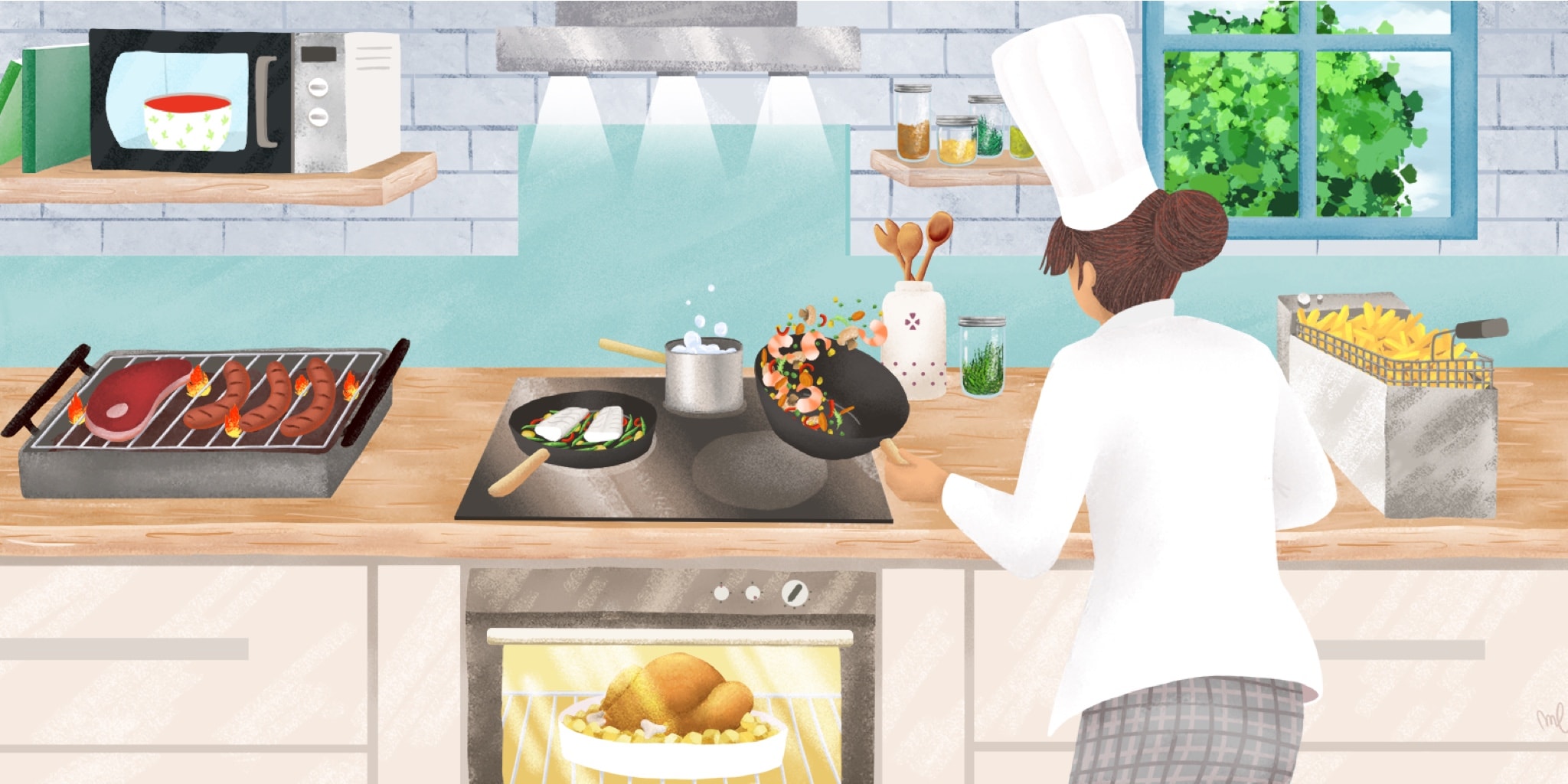
Cooking your meals has its benefits. It not only makes fiber more digestible but also enhances the absorption of several nutrients. However, it’s important to be aware of the drawbacks. Cooking can reduce the nutritional value of your food by destroying essential vitamins and minerals. Specifically, heat-sensitive vitamins such as Vitamin C, B1 (Thiamine), and B9 (Folic Acid) can lose up to half of their content during the cooking process.
Yet, not every cooking method impacts food the same way. Some techniques are more effective at preserving your ingredients’ nutritional quality. Generally, the shorter the cooking time and the lower the temperature, the better it is for retaining the food’s nutritional content.
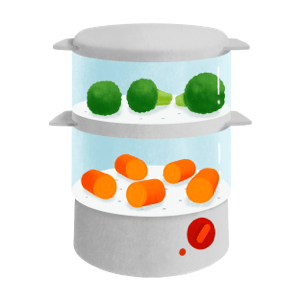 | Gentle steaming |
This technique uses a low-temperature steamer (meaning the temperature remains below 212°F). It is the most appealing solution to optimize nutritional quality and preserve as many vitamins and minerals as possible.
It also maintains the flavor and texture of foods. This appliance is frequently used to cook vegetables, but it works with many other foods, such as legumes, fruits, poultry and fish.
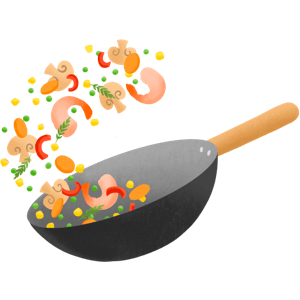 | Stir-frying |
Stir-frying is very common in Asian cuisine: the technique consists in sautéing foods in a wok or skillet.
This is a very quick cooking method: food is seared on high heat for just a few seconds, which limits the deterioration of the food’s inherent nutritional quality.
This cooking method is also appealing because it does not require much oil.
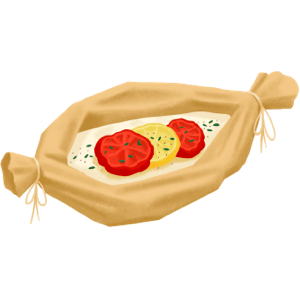 | Cooking en papillote |
The French term “en papillote” refers to cooking ingredients in parchment (or aluminum foil). With this method, food is sealed in a pouch made from aluminum foil or parchment paper, then cooked in an oven or microwave. The food is protected inside the pouch, which helps to preserve nutrients.
However, cooking en papillote is usually done at a high temperature (250°F or higher), which diminishes the food’s nutritional quality.
If you opt for this method, it is better to use parchment paper to prevent any transfer of metal particles from the aluminum foil to your food. In addition, aluminum foil cannot be used in microwave ovens; only parchment paper is suitable for using a microwave to cook en papillote.
Furthermore, you should never add any acid (e.g., lemon, white wine or vinegar) when cooking with aluminum because the acidity promotes the absorption of aluminum.
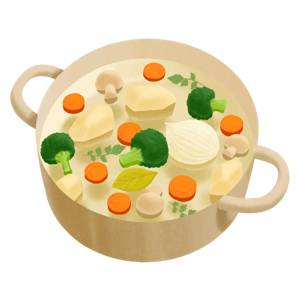 | Water poaching |
To poach foods in water, the food is held at a high temperature for a lengthy period, which lowers its nutritional quality. Thus, it is preferable to poach at a low temperature and to avoid bringing foods to a boil.
In addition, some of the minerals (and vitamins, to a lesser extent) migrate into to the cooking liquid. Thus, we recommend that you consume this poaching liquid where possible. You should also choose organic vegetables to avoid consuming any pesticides that may have migrated into the cooking water.
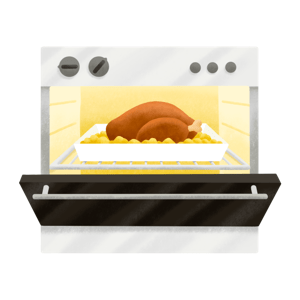 | Baking |
Baking takes a long time and often requires very high temperatures. Thus it has a major impact on nutritional quality.
Furthermore, it promotes the Maillard reaction, which is the chemical reaction that occurs in high-temperature cooking and creates Maillard products. The reaction lends foods a brown color and enhances their flavors. For example, Maillard products are responsible for the characteristic taste of the crispy skin on an oven-roasted chicken. However, Maillard products encourage oxidative stress, which accelerates cellular aging and increases the risk of cancer (see our post on antioxidants).
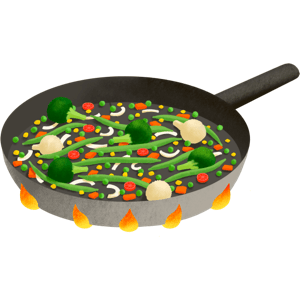 | Pan frying |
Pan frying also requires high temperatures and a relatively long cooking time. As such, this cooking method should be limited.
It is also important to choose an oil suited to cooking: olive oil for low temperatures and coconut oil for high temperatures. You should never bring an oil to its smoke point, as this makes it toxic.
Similarly, you should absolutely avoid browning butter. If you cook with butter, choose ghee (i.e., clarified butter) because it tolerates higher temperatures better than butter.
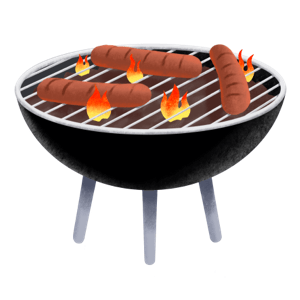 | Grilling |
When you grill meat, the fats in the meat drip into the charcoal and catch flame: the resulting smoke contains a carcinogenic substance (benzopyrene) and several other toxic compounds that permeate the meat.
According to a study, a grilled 3.5-ounce steak may contain as much benzopyrene as 120 cigarettes (Kaisennan, 1996). This is why it is recommended that the meat be cooked at least 4 inches from the coals.
If you cannot resist grilled meats in the summer, the best approach is to use a plancha or a vertical grill, which allows the smoke to escape into the sky without entering the meat. You should also marinate your foods before cooking as it reduces the amount of toxic compounds they absorb.
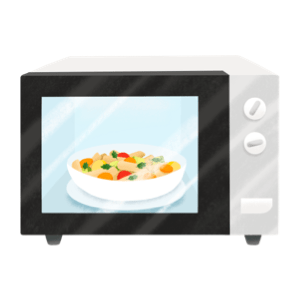 | Microwaving |
There is wide disagreement among experts about the dangers of microwave cooking. Some believe that, if the microwave oven is not damaged, it cannot emit dangerous amounts of radiation.
However, others are concerned because microwaves cause unnatural changes in food structures by agitating their water molecules, and we do not yet know the full extent of the potential effects and consequences of such action.
Because the matter has not been settled, it is advisable to use the microwave in moderation.
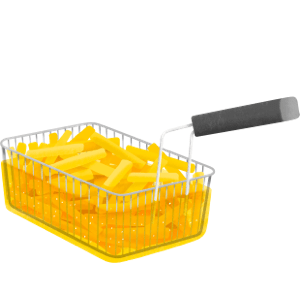 | Deep frying |
This high-temperature cooking method favors the production of troublesome compounds through the Maillard reaction.
In addition, browning food in a fryer also produces acrylamide, a molecule that promotes the development of cancer and becomes neurotoxic in high volumes. This molecule is formed mainly when sugars are present. For example, the sugar in potatoes will encourage the production of acrylamide when cooked in a fryer.
Finally, deep frying foods increases their fat content. Frying oils are usually high in omega-6 and saturated fatty acids, two kinds of fat that are already over-consumed (see our post on fats).
 | Air Fryer |
The air fryer presents an interesting alternative to traditional frying methods, allowing for a significant reduction in fat content by about 70% to 80%.
However, this cooking method does not eliminate the issue of producing Maillard compounds, which are problematic substances that form during the browning of foods. Therefore, while it offers a good compromise, it should be used in moderation.
- Lee S, Choi Y, Jeong HS, Lee J, Sung J. Effect of different cooking methods on the content of vitamins and true retention in selected vegetables. Food Sci Biotechnol. 2017;27(2):333-342. Published 2017 Dec 12.
- Jiménez-Monreal AM, García-Diz L, Martínez-Tomé M, Mariscal M, Murcia MA. Influence of cooking methods on antioxidant activity of vegetables. J Food Sci. 2009;74(3):H97-H103.
- Yuan GF, Sun B, Yuan J, Wang QM. Effects of different cooking methods on health-promoting compounds of broccoli. J Zhejiang Univ Sci B. 2009;10(8):580-588.
- Bastías JM, Balladares P, Acuña S, Quevedo R, Muñoz O. Determining the effect of different cooking methods on the nutritional composition of salmon (Salmo salar) and chilean jack mackerel (Trachurus murphyi) fillets. PLoS One. 2017;12(7):e0180993. Published 2017 Jul 7.
- Andlauer W, Stumpf C, Hubert M, Rings A, Fürst P. Influence of cooking process on phenolic marker compounds of vegetables. Int J Vitam Nutr Res. 2003;73(2):152-159.
- Ferracane R, Pellegrini N, Visconti A, et al. Effects of different cooking methods on antioxidant profile, antioxidant capacity, and physical characteristics of artichoke. J Agric Food Chem. 2008;56(18):8601-8608.
- Carcinogens in Tobacco Smoke: Benzo[a] pyrene from Canadian Cigarettes and Cigarette Tobacco, M.J.Kaisennan, W. S.Rickert, American Journal of Public Health, 1992
- Analysis of 200 food items for benzo[a] pyrene and estimation of its intake in an epidemiologic study, N.Kazerounia et al, Food and Chemical Toxicology 39, 2000
- EFSA – https://www.efsa.europa.eu/fr/efsajournal/pub/4104
- INFOSAN – https://www.who.int/foodsafety/fs_management/No_02_Acrylamide_Mar05_fr_rev1.pdf
- Anses – L’acrylamide dans les aliments : https://www.anses.fr/fr/content/l%E2%80%99acrylamide-dans-les-aliments
- Parada H Jr, Steck SE, Bradshaw PT, et al. Grilled, Barbecued, and Smoked Meat Intake and Survival Following Breast Cancer. J Natl Cancer Inst. 2017;109(6):djw299. Published 2017 Jan 5.
- Uribarri J, Woodruff S, Goodman S, et al. Advanced glycation end products in foods and a practical guide to their reduction in the diet. J Am Diet Assoc. 2010;110(6):911-16.e12.
- Tamanna N, Mahmood N. Food Processing and Maillard Reaction Products: Effect on Human Health and Nutrition. Int J Food Sci. 2015;2015:526762.
- Trevisan AJ, de Almeida Lima D, Sampaio GR, Soares RA, Markowicz Bastos DH. Influence of home cooking conditions on Maillard reaction products in beef. Food Chem.
- Virk-Baker MK, Nagy TR, Barnes S, Groopman J. Dietary acrylamide and human cancer: a systematic review of literature. Nutr Cancer. 2014;66(5):774-790.
- Brownlee M. Advanced protein glycosylation in diabetes and aging. Annu Rev Med. 1995;46:223-234.
- Zhi WJ, Wang LF, Hu XJ. Recent advances in the effects of microwave radiation on brains. Mil Med Res. 2017;4(1):29. Published 2017 Sep 21.
- Jiang H, Liu Z, Wang S. Microwave processing: Effects and impacts on food components. Crit Rev Food Sci Nutr. 2018;58(14):2476-2489.
- Anses – Four à micro-ondes et substances chimiques des emballages alimentaires : https://www.anses.fr/fr/content/four-%C3%A0-micro-ondes-et-substances-chimiques-des-emballages-alimentaires
- Caponio, F., Pasqualone, A. & Gomes, T. Effects of conventional and microwave heating on the degradation of olive oil. Eur Food Res Technol 215, 114–117 (2002).







Thanks guys. Over 80 and finding raw fruit with peal on or in smoothies less and less digestable or with “apricot” tummy, so am going to try your notes on steaming.
Kind regards. Jan du Plessis George in RSA
Are cooked fruits still healthy…..your quote….WRONG. unless you meant ‘are they not rotten’. What you should be saying is ‘ARE COOKED FRUITS STILL HEALTHFUL. I teach English…
sybau unc
Lowest temperature for the shortest time is a good rule of thumb. I am pretty sure that the fiber will still be good for your gut if not boiled into a mush. Al dente Vegetables are best. Eat the skin of apples and potatoes, the color is the antioxidant.
my question if you will answer, when cooking a meat soup with veggies and they are cooked a bit longer, does veggies still have fiber and nutrients, or does it just all become part of the soup and the meat, say chicken, does it have any nutrient value left…????? or does the meat just become just a nutrientless pill of nothing.. sure would like an answer…..
What about slow cooking/ braising ?
This is very interesting. What about pressure cooking and slow cooking as in a slow cooker?
Thank-you for this post it was very educational..
Love this app but what about slow cookers?
Great article but what about slow cookers and crock pots?
I have a question about grilling meat & fish. We cook a lot this way but without charcoal because we use wood chips and a Traegar Barbeque, which allows us to smoke the meat at a lower temperature first and later turn up the heat to sear the outside before eating. Does this method still contain the benzopyrene discussed above?
Wondering about propane grilling. We do not use charcoal. Does using a smoker have the same issues?
Thank you for the beautiful information’s; we are out here to learn day to day!
We must save ourselves by getting the best food out there because what is written on some foods are there to fool the people.
Example Chicken Broth with the sodium, when it say only 5 % sodium / watch how many 105 mg portions. some company will say for 650 mg will be higher 31 %. Please do the math to get it right. Which one in higher?
Recipes with method of cooking to protect nutrients?
Love this app, it helps me make better choices. Thank you yuka
Thank you, always educational and enlightening. I learned about the dangers of Maillard. Yesterday, oil spilled on the buttom rack of my oven cooking beaf at 400F. It created a lot of fumes. Did my meat and air in the kitchen become contaminated by Maillard? 😳 looks like ovens are a bad choice too for causing high temperature cooking?! Are we left with just steaming everything including meats and chickens? Very confused 🤔
Thank you for all of your research and sharing it with us! Absolutely love your app and share it with others every chance I get!
This is a well written article that help me make better choices and responsibility for what I put in my mouth! However, I love crispy food. That one might be hard.
When are we going to organize as a group and go after food manufacturers and make them stop killing us with poisonous additives they are putting in our food. Microwave ovens should be banned. Laws should be passed to ban these poisonous additives. This is serious. Somebody needs to do something. Thank you.
I honestly believe the only way to send the message is with our $$$. We have the power as consumers. Stop buying or supporting these companies that make products that harm us. We have the choice.
I couldn’t agree more! AND big pharma wants us to stay unhealthy!
Great information.Learned a lot from this article 🙏
Thank you for informing me.
Thanks for the great article. It explained a lot of things. Now I know what to do what not to do
Good article. Explained clearly. Thank you for the valuable information.
That was a good article. It seems that low heat cooking is the ideal.
I have a memberhip and I have lost my ability to scan.
I learned a lot with this article – thank you!! I was just wondering about cooking on the air fryer. I just got one and I am little resistant. Does it keep the nutrients?
thank you, nadia
This is sooo helpful I use it when I can
Thank you for providing such a great information!!
Great information Thank you, Appreciate!!
Thank you! Very interesting about the oven. What about using an outdoor smoker?
You did not mention the instant pot for soups and beans. I no longer eat meat and get the lectin out of them being you have to cook them at least an hour.
Thank you for the information, most of it I knew. The microwave still a question
Thank you for the helpful information.
I fry veggies with water, never oil
, thank you for your insight. More government policy should be based on these facts not corporate greed and lobbyist
Any research on air fryers?
This article is very interesting and informative. Thank you for sharing. I understand the joy of cooking so much more.
What about using air fryer?
I feel much more knowledgeable and aware. Thank you.
Great Information. Thank you so much.
I also use Air Fryer, Instapot, and Slow Cooker a lot. Any advise on those? Thanks!
I have the problem down packed. Please offer more solutions to healthy cooking methods.
Gas grills are also very healthy!
Thank you so much for the good information
Great information. What about the Air Fryer method?
Hi! Thank you so much for the article. I feel like the only method of cooking that is advisable is the gentle steaming, and the rest have warnings associated. Is that correct or do you have suggestions on what temperatures to bake and sauté foods such that it maintains its nutritional value?
Curious what your perspective is on pressure cooking ?
Good question.
Thanks for all the information. I’m not sure what changes I’ll make. It is making me think about how I cook.
I ditched my microwave. Don’t miss it at all. Wish I had done it decades ago.
I would love a link to the Kaisennan, 1996 research paper. I can’t find it online.
You guys are the BEST!
I don’t know what I’d do without my Yuka app and your great advise through email. I love your app. And we are eating so much better now.
Thank you.
Angie D.
Very interesting article. I will save money by not using aluminum foil and switching to the parchment paper. I have seen the visible effects of acid based seasonings on aluminum foil when stored or wrapped.
What about crock pot cooking?
Great article, interesting things to consider when cooking .
Absolutely love this app and am hoping they add to with animal foods and supplements 😁
I would love to learn how air frying impacts the nutrition value of foods. The temperature is high, but duration is low. When wrapped in foil, food still cooks and get’s hot.
I have many recipes that specifically say to heat the oil until just smoking before adding the food.
Microwave in Moderation like all Life! In moderation
Thank you for your information which it gave me more insight.
“Because the matter has not been settled, it is advisable to use the microwave in moderation.” Sorry, but I believe if something has not been settled yet, and could be negative for our health, please do not use it! There are multiple examples such as Teflon, glyphosate, etc. that were thought to be harmless and many people have died because of them. We are talking about our lives, not a trifle.
If there’s NO substantial base of evidence that something causes harm, then why would you stop doing it? Just because it’s a possibility does NOT mean that you should change the way you live your life. There’s a possibility I could die driving my car today – does that keep me hidden away in my house? No, it does not. And there’s plenty of evidence that shows how dangerous driving is – in fact, it’s probably the riskiest thing you do every day – much more dangerous than a big, bad microwave. We are talking about living here.
Would love for this to include pressure cooking! This is a very popular method of food preparation, and should help retain more of the nutritional value since lower temperatures and cooking times are required (under high pressure).
Thanks for the info. I love the app. I tell all my friends. They don’t like the results sometimes, but it’s good info. to know. I would like to know about air fryers also.
Thanks for the article. Air Fryers are popular at the moment and since they use a higher temperature (typically) does that mean they also destroy more nutrients? I know they are primarily promoted as good for the fact they use less oil for cooking… but it’s still hot as Hades in there. I use your app for a unit I teach and enjoy all aspects of your creation. Thank you!
I see many comments about using an air fryer. However, you did not address the air fryer cooking process in the article. Would love to know your findings. Thank you.
Sorry, don’t know why this posted under your post. Meant for it to stand alone. 🤷♀️
Air fryers cook 20% faster than conventional ovens
The study about grilling and everything else I could find only indicates the presence of carcinogens in browned meat, it doesn’t discuss the absorption or incidence of cancer for eating grilled meats. Is there any evidence that eating grilled meat is actually related to cancer?
I guess if you grill your meat until it’s charred/brown then that would qualify as brown meat….???
You didn’t mention air frying.
…or slow cooking (crock pot) or pressure cooking.
They did, just not in great detail
Kind of surprised you didn’t discuss air fryers
I have been using an Air Fryer for most of my cooking of meats and fish. How do you rate Air Frying?
Great article. I use a slow cooker often. Can you provide some insight on this cooking method?
What about instant pot pressure cooking?
Coconut oil should never be used at high temperatures. Where did you see this information?
Great article, very informative. Could you address using air fryers as a cooking method, please?
Thank you!
Thank you for sending this valuable article.
Use your app daily.
Thanks for the article. Love my Yuka and membership is reasonable! A great help in purchasing healthy non toxic items!
I love the Yuka app. I use it every time I buy groceries. I tell all of my friends.
You have made me eat healthier and I thank you for that.
Love your app and articles.
Thank you for your wonderful app.
I love the taste of (oven) roasted vegetables. Since this uses a heat of 400 – 425 degrees, is it an undesirable method?
Great information.
What about the air fryer?
Yes! I wanted to know that too!
I love your app
Thank you
Thanks, Very interesting information
What are your thoughts on instant pot cooking
Great info keep it coming
great info, but where’s the holy trinity of non-nuke, lazy cooking… pressure cooker, air fryer, and sous vide lol
There was no mention of cooking in a pressure cooker
I love the Yuka app. I use it all the time. I cleaned my pantry with it. Take it with me shopping. I’ve changed my skin care and make up with it. If I order something on line and it doesn’t get a good rating with Yuka, back it goes. It has helped me immensely. I’ve told my family and friends about it. And have recommended it on FB.💕
Any comments on Air frying?
Thank You Julie for the great information. Love my YUKA!
Thank YOU Julie
This is the best app & im super happy & pleased to be a part of it. I have shared it with everyone, family, friends, strangers in the store who see me scanning. I preach about it at the salon, workouts, schools, my kids even use it!
Stay true! We believe in this app.
Absolutely correct Brandy
Love yuca
What about sous-vide?
Why doesn’t the YUKA app penalize foods for containing seed oils?
Yeah same with Olive oil 🫒 which is absolutely ridiculous
Wish the Yuka app would rate the seed oils too!
What about an air fryer ?
Thank you. This is very helpful and appreciated
Thank you for all that you do for us❤️ I hope you will consider adding vitamin supplements to test for toxins like Magnesium Stearate (not from a vegetable source) and vitamins produced in a lab vs water soluble natural vitamins 👍🏻
Avocado oil has a higher smoke point than coconut oil.
Very good info but what about slow cooking, pressure cooking, sous vide and air frying?
What about pressure cooking? I’ve always understood this was one of the best ways to preserve nutrients in foods.
Very interesting article. Thank you to the entire Yuka team. I’ve been a Yuka follower for over 5 years, maybe even 10 (in France !)
Thank you for your time, reasearch and education. Stay healthy people
What about the currently popular air fryers? High heat, but quicker cooking times and no oil.
What about air frying and Sous Vide?
How about air fryer what is the advantage and disadvantages
Thanks for this great info. Can you make recommendations as to the safest, nontoxic cookware?
Thanks !
Thank you so much sending me about cooking food without losing nutrients. There’s so much information about foods stuff. Hopefully we can have perfect healthy food near future?
Always use stainless steel cookware. Do not use aluminum cookware. Also home goods store have safe cookware, its masterclass premium cookware and its say healthy cookware. I hope company telling me the truth??
Cast iron or metal pots and pans
Ditch the non-stick pans
What are your thoughts on the Sous Vide method?
My nutritionist has told me not you use the sofrito method of preparing food (Italian dishes). That is, sautéing chopped onions, garlic, carrots and celery in olive oil. She said to sauté in water instead of oil and then add the extra virgin olive oil “al crudo” (unheated) for flavor and nutrition at the end before eating. Your thoughts?
Yes I agree, do not cook with olive oil, especially extra virgin.
I use avocado oil or even a little bit of broth for cooking.
I add a bit of olive oil at the end to a sauce once it is off the heat.
Thanks I will try this method
What about air frying?
Thank you for this valuable information and for your wonderful Yuka app. I use it all the time. I had been looking for a source of trustworthy information on food and nutrition as well as cosmetics. Through Yuka I have found the best and safest products. Again, thank you and keep up the great work!
What do you think about air frying food? Is it healthy?
High temperatures degrade more nutrients, shorter times retain nutrients, so healthier than frying in oil. Maybe the same as baking because the shorter times vs higher temperature probably make the same degradation.
A non-research-based answer
I look forward to your newsletter! Explains in a easy and logical way… I’ve changed so many food choices now while using the app at the grocery store. It’s alarming to know so many foods and drug store items are just not healthy…
You guys are great! Keep up the amazing work you do for all of us! ❤️👍
Thank you for the information. What about using a crock pot?
You guys are the best!
Thank you, I love the informative news you share . Stepping over to more plant food and part vegan this has many helpful ideas .
We have many studies on microwaves and food. They vibrate the water molecules, and the cooking is similar to steaming. It’s considered the best cooking method to retain nutrients so long as you use the right cooking time and have enough water. You can put a cup full of water in the microwave when you cook to ensure the food has enough water.
If it doesn’t have enough water, that’s when the temperatures can get too high and impact acrylamide and flavonoids content. When reheating, use lower power. And obviously, no plastic. I learned most of this from the WHO.
Technology can be amazing because it helps us get away from our limited cave man days with open fire and high carcinogens, and I think the biggest issue with microwaves is people are afraid of them..
I wouldn’t take any Advice from WHO!!!